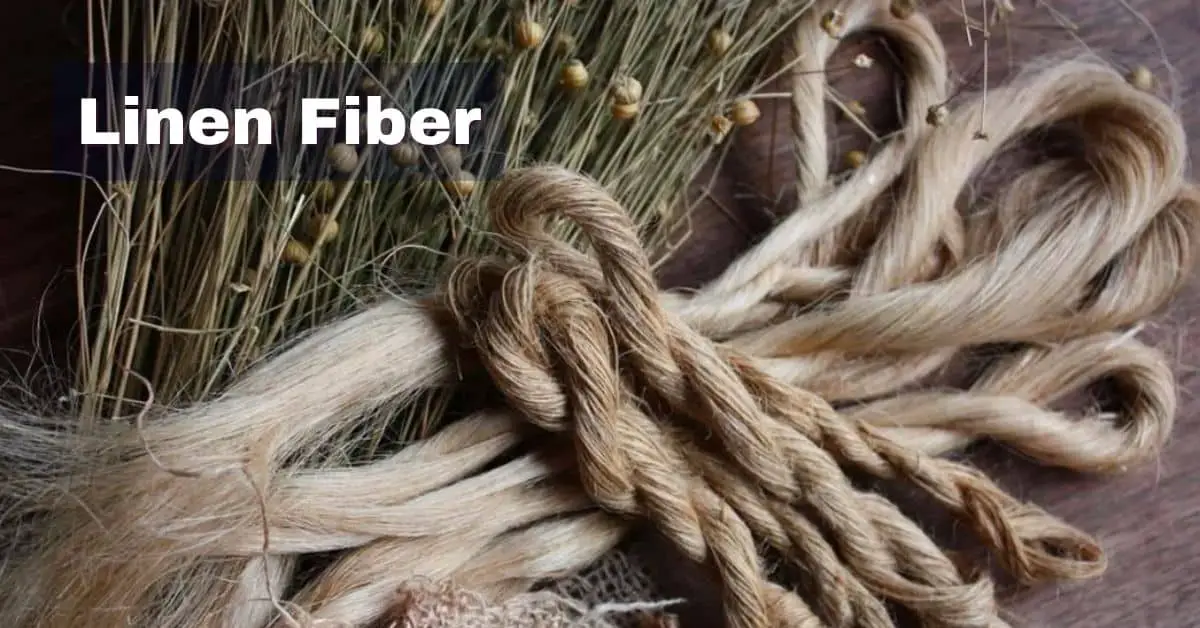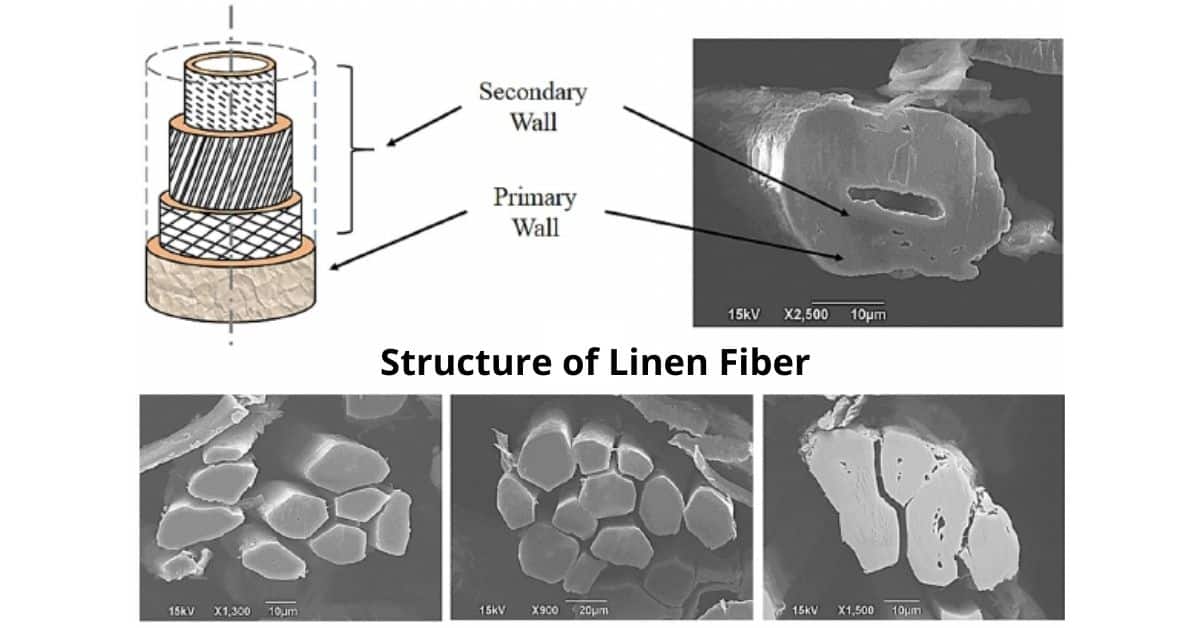Let’s continue our series on understanding natural fiber; in my previous blog, I shared some knowledge about cotton classification. Today, I am going to discuss what linen fiber is.
Before explaining the linen fiber description, I want to ask you one question: How many clothes or pants are made of linen in your wardrobe? You can comment below; let’s see who has the most.
What is Linen Fiber?
Linen is a kind of bast fiber that comes from the plant’s inner part. In the case of linen, that plant is flax. Linen is the term applied to the yarn spun from the flax fibers. It is also a cellulosic fiber and is more costly than cotton fiber. Because cotton is available in the form of natural fiber, linen must be extracted from bast.

Linen is a strong, durable, absorbent fiber and dries much faster than cotton. To make you clear about Linen, I prepared 7 parts of knowledge:
- Origin of Linen Fiber
- Linen fiber structure
- Linen Fiber Cultivation and Manufacturing
- Types of Linen
- Linen properties
- Advantages of linen fiber
- Application of Linen Fiber
ok, coming towards our first point:
Origin of Linen Fiber
Usually, the word “Linen” refers to a textile made from the flax plant’s fibers; history is accepted to be some of the oldest in the world. Linen was used in ancient civilizations like Mesopotamia and ancient Egypt, They used to wear and mummify their dead. Dyed flax fibers, which may date back over 30,000 years, were found in caves of present-day Georgia.
Linen fibers should not be confused with bed linen, but they are connected as in ancient times, linen fibers were closely associated with throws, bedsheets, and ropes.
In the eighteenth century, with the invention of power spinning and the cotton gin, cotton started to replace linen as the widely used natural fiber. Before that, the two fibers primarily used in clothing were Linen and Wool.
For now, Linen has less share in textile products compared with cotton.
Bast fibers are the second most-produced natural fiber. Flax, Ramie, Hemp, and Jute are the most known bast fibers. These four fibers have almost the same properties and extraction method because they all come from the bast of the plant.
The difference is the plant from which they were extracted. Jute is somewhat noticeable because of the harsh nature of the fiber. But for hemp, ramie, and flax, It is very difficult to tell apart between them apart, especially at the fiber and fabric stage from visual appearance.
- Ramie
- Jute
- Hemp
According to statistics from the FAO (Food and Agriculture Organization of the United Nations), the major flax fiber producer in Europe, it has 77% of the global share. Next in line is China (17.4%), Egypt (3.6%), Chile (1.25%), and Argentina (0.75%).
How was Linen Fiber made?
Ok, the above is the basic introduction to Linen. Now, I will discuss my second point:
Linen Fiber Structure
Linen fiber description: Linen fibers are present in the stem of the plant in the form of bundles of individual fibers held together by gum. The length of fiber bundles ranges from 20 to 100 cm. The longitudinal view of flax fiber under the microscope is not like cotton. Fibers have no twisted structure, but longitudinal lines or grooves are present called nodes; the nodes are spaced irregularly along the length. Look, here are the nodes at linen fiber under microscope.

The chemical structure of linen contains cellulose, cellulose present in all plant-based nature fibers. Here is the chemical composition of Linen; cellulose takes up 74%.
Ok. Now I will talk about the cultivation and manufacturing of Linen fiber.
The flax plant is an annual crop; it grows in temperate and subtropical areas of the world, with a height of 4 feet. The life cycle of a flax plant starts in early spring and ends in mid-summer. The Planting will be done when the temperature of the soil is around 7–8 0C, and during the planting, there should be spacing between them. Otherwise, it will cause branching of the stem and generally cause the lower height of flax fiber, which means shorter fibers.
Ideally, flax should be grown for approximately 107–110 days until the early-yellow stage of maturity. It happens when the bottom quarter part of the stem loses leaves and becomes yellow. The upper part of the stem is still green but with a yellowish tone, and the seed capsules are yellow and fully matured. It is the best time for flax harvesting about fiber quality, as it affects fiber composition; the longer the plant grows, the more increase happens in fiber stiffness.
The flax plant is harvested by pulling out the plant from the soil. It can be done by hand or with a machine and laid on the field. The flax plant is then collected and bundled together for drying purposes under sunlight. The process is called stocking. The next step is the removal of seeds and leaves from the plant, which can also be done by hand or machine. The top ends of the dry bundles of flax are pulled through nails hammered into a board, like a comb, and the seed extract is used as linseed oil for food and other applications.
The next step in linen fiber manufacturing is the most important and is known as Retting. The gum between the bundles of fiber is removed in this process by using bacteria. There are 5 methods of retting.
- Dew Retting
- Water Retting
- Wooden vat Retting
- Chemical Retting
- Enzyme Retting
Once the fibers are loosened by retting, the process of Breaking and Scutching is used to break up the inner woody stalk into smaller pieces to separate it from the linen fiber. For this purpose, rollers or wooden blades can be used.
The last step in the production of Linen Fiber is the hackle. Small fibers remain on the comb and are removed to make low-quality coarse fabrics. The hackled linen fiber is the finest fiber and can be used in high-quality linen products.
I think you have likely heard of different types of linen that are named after a specific country, such as Belgian linen, French linen, and Irish Linen.
But do you know, There are several types of Linen according to the weaving of fabric: let me tell you some of them:
1. Damask Linen: The name comes from the Syrian capital of Damascus. Damask linen is more delicate and has been compared to embroidery)
2. Plain-Woven Linen: Plain (1/1) durable weave used to produce apparel textiles
3. Loosely-Woven Linen: it is Highly absorbent and least durable and used to produce reusable products
4. Sheeting Linen: No texture, soft surface, or close weave are used in the textile industry.
For all the linen fabric products and samples, in the future, when I talk about fabrics, I will explain the details of each linen fabric. So please subscribe to my channel, and don’t miss the important fabric knowledge.
And now, I will discuss the properties of Linen Fiber.
1. Length of linen Fiber:
Different kind of linen has different lengths; look at this table:
| Fiber Name | Length of Fiber |
| Flax | 0.5-15 cm |
| Hemp | 0.5–4 cm |
| Ramie | 13-15 cm |
| Jute | 0.16-0.25 cm |
Moisture Regain:
Moisture Regain of linen is 12-14%. So, it is straightforward to wear garments made from linen
Morphological Structure of the linen fiber:
It has the same crystalline structure as cotton. Fibers have a round structure and have longitudinal nodes when seen under a microscope. These nodes provide the necessary strength to the fiber.
Physical Properties:
Including Strength, Elasticity, and Abrasion resistance.
The strength of Linen fiber before deformation is high because of its crystalline structure and nodes. The elasticity of linen is very poor because the linen fiber crystalline area is highly oriented/ or straight.
The abrasion resistance of linen fiber is moderate, and the nodes on the fiber surface cause the abrasion.
Fiber Chemical Properties
- Effect Acids: Linen withstands weak acids but is attacked by hot, dilute or cold concentrated acids.
- Effect of alkali: Flax is resistant to alkaline solutions for large amounts of gum and waxes.
The dyeability of linen is moderate.
These properties benefit from the advantages that linen fiber gives. It is an environmentally friendly fiber. The Strength is high and can be made into a long-lasting garment. After multiple washes, the Stiffness of the fiber dies down, and a soft feel around the skin. Linen fiber is more comfortable in warm weather.
Linen fiber has widely ranged across home textiles, apparel textiles, and industrial products. Such as bed and bath fabrics (tablecloths, bath towels, dish towels, bedsheets); home and commercial furnishing items (wallpaper/wall coverings, upholstery, window treatments); apparel items (suits, dresses, skirts, shirts); and industrial products (luggage, canvases, sewing thread).
Linen is one of the good friends in our life.
Well, guys, I think you have some knowledge about linen fiber. If you have any suggestions, please leave comments below. And if I have missed something, please tell me because textiles are a sea of knowledge, and I cannot cover everything quickly. Also, if you like my content, please give me a thumbs up; it will give me some extra motivation to bring informative and professional knowledge to you. In my next blog, I will tell you about viscose fabric.
Thanks for reading the whole blog. See you next time, bye.

Have you ever thougfht about addin a litttle bit mre
than jusst your articles? I mean, whhat you say is important and
everything. However thinhk of if you added some grewt visuals or video cliips to give your posts more, “pop”!
Your content iis excellent but with images and clips, ths site
cojld cedtainly be onne of the most beneficial in its field.
Awesomne blog!